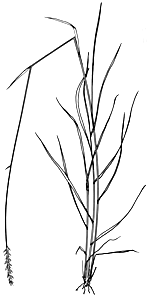
Description: Erect or scrambling perennials with stems to 2 m long.
Leaves with ligule membranous, glabrous or ciliate; blade rolled in bud.
Inflorescence of 1–many appressed racemes, appearing spike-like, diverging later, rarely solitary; rachis readily disarticulating.
Spikelets paired, 6–10 mm long, 1 pedicellate and 1 sessile, both similar or differing in sex; pedicels and internodes inflated. Sessile spikelets dorsally compressed, falling with the pedicel and adjacent axis internode; florets 2, lower usually male, upper bisexual. Glumes subequal, lower dorsally flattened or convex, strongly nerved upwards, 2-keeled; upper keeled, sometimes awned. Lower lemma not awned; upper usually 2-fid and awned from the sinus. Paleas 2, subequal to lemmas. Pedicellate spikelets either similar to the sessile in sex and form, or male, or reduced, sometimes appearing laterally compressed; falling entire from
Distribution and occurrence: World: c. 65 species, Old World tropical regions. Australia: 10 species (9 species native, 1 species naturalized), Qld, N.S.W., N.T., W.A.
Text by S. W. L. Jacobs & C. A. Wall
Taxon concept:
| | Key to the species | |
| 1 | Glumes hairy; racemes 6–20 cm long, slender; naturalized pasture species on NWS | Ischaemum afrum |
| Glumes glabrous; racemes 4–12 cm long, robust; native species of swampy and sandy areas of coast | 2 |
| 2 | Nodes glabrous on the stout, trailing culms; leaves usually 6–12 mm wide; sessile spikelets c. 3 mm wide, obtuse | Ischaemum triticeum |
| Nodes hairy on erect, rather slender stems; leaves 3–5 mm wide; sessile spikelets c. 2 mm wide
Back to 1 | Ischaemum australe |
|


